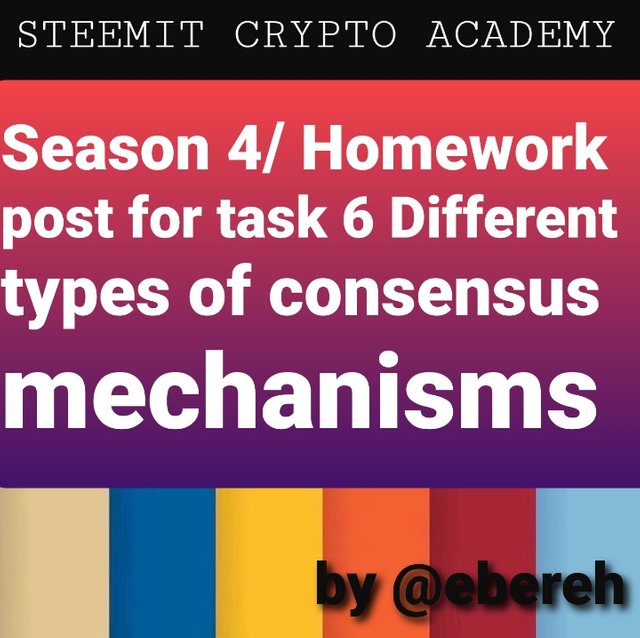[Different types of Consensus Mechanisms] ... Steemit Crypto Academy Season 4 ... Homework Post for Task 6 by @ebereh

image edited from the author's gallery
Good day Everyone, I'm here to carryout my 6th task for the person of professor @sapwood. For the purpose of the completion of this task, this write up will be centered on "consensus mechanisms", with a particular question hoping to be dissected and answered to give a proper understanding to readers.
QUESTION.
What is the difference between PoW & PoS? Advantages & Disadvantages? Which one is better in scaling Capacity? Examples?
CONSENSUS MECHANISMS
Basically, a consensus can be described to be the general agreement over a particular thing or things. With that brief definition of what a consensus is, I then bring to limelight what a consensus mechanism is.
On the other hand, with the knowledge of what consensus is, consensus mechanism can be said to be a system, in which a large number, usually more than half of nodes in a particular system reach an agreement upon a single value, thereby the majority is given the vote system for the purpose of enabling nodes sync. This system is important because, unlike in a centralized system where the central authority's decision is final, decentralized system makes gives everyone an equal say through a consensus. Consensus mechanism number up to 8, with various purposes. But for the purpose of this task, I will be focused on only two which are;
- Proof of work (PoW)
- Proof of Stake (PoS)
PROOF OF WORK
What is Proof of work?
Proof of work is a consensus mechanism as stated above, which makes use of computing efforts to break down and elaborate on mathematical puzzles, to solve it's complexity too. Furthermore, tasking miners with the validation, recording of transactions.
Miners as stated above are tasked with the duty of solving cryptographic puzzles and validating transactions and also verifying those transactions whenever they end up at the unconfirmed pool. Thereby adding the validated ones to the block.
The selection of these miners occur at random to ensure proper decentralization thereby, limiting scaling capacity.
Proof of work is usually used due to the advantages it has and those advantages are;
Advantages
● Proof of work is very profitable, when all the requirements are met.
● It is a decentralized mechanism and has no involvement of third parties in transaction validation
● It reduces the risks involved in double spending through the solving of complex puzzles or mathematical equations
Also its disadvantages are also unnoticed, which are;
Disadvantages
● High cost when carrying out
● it wastes alot of energy especially when mining
● It is slow and time consuming compared to the PoS algorithm.
PROOF OF STAKE
Just like the former, proof of stake is another consensus mechanism which can stand as an alternative for the proof of work. One of it's major difference with the proof of work is that this mechanism uses validators rather than miners for it's validation process. The validators are required to lock up or stake a certain amount of native token which would serve as collateral. These validators agree on the transactions to be added to the next book.
The proof of stake is not only more efficient than the proof of work, but also requires lesser energy and electricity to undergo, thereby being faster in the performing of transactions.
Just like the proof of work, the proof of stake also has it's advantages and disadvantages.
Advantages;
● During the forgoing process, they consume lesser energy
● It is highly scalable and also highly secure
● Unlike the PoW it needs lower barriers to enter
Disadvantages;
● People with the highest stake, have the highest stake, say and influence
● Once tokens are locked, they can't be unlocked until a specific period of time.
● Miners get higher block reward than validators
DIFFERENCES BETWEEN THE PROOF OF WORK AND PROOF OF STAKE
| PROOF OF WORK (PoW) | PROOF OF STAKE (PoS) |
|---|---|
| Transaction validation process is called mining | Transaction validation process is called forging |
| Proof of work is carried out by Miners | Proof of stake is carried out by validators |
| The validation process called Mining, requires alot of energy to carryout | The transaction process called called Forging, dosen't require alot of energy to carryout like the PoW |
| High level of computer usage and high level of tech expertise is required | High level of tech or computer experience is required as it could be accessed from a basic desktop |
| They are expensive to carryout and also slower than the PoS in carrying out operations | They are less expensive than the PoW and also faster in carrying out operations |
SCALING CAPACITY
Scaling Capacity is simply the amount of cryptocurrency transactions bring carried out within a given or particular time frame.
Therefore, Proof of Stake mechanism possesses a higher Scaling Capacity over the Proof of Work mechanism as it carries out more transactions as fast as possible with a short period of time.

This is a copyright free image of BTC (Bitcoin) which makes use of the Proof of Work mechanism. Furthermore, it also validates 4.6 transactions within a second. An example of PoW cryptocurrency is ethereum.

This copyright free image of ALGO (Algorand) above, makes use of the Proof of Stake mechanism, also performs approximately 1200 transactions within a second. This shows that the Scaling Capacity exceeds that of the PoW.
In conclusion, with this task write-up, we have an understanding of the proof of work and the proof of stake. Its advantages and it's disadvantages, and the differences between the both of them. Also the one which has a better scaling capacity.
